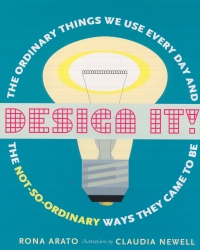| ________________
CM . . . . Volume XVII Number 18. . . .January 14, 2011. 
 |
Design It: The Ordinary Things We Use Every Day and the Not-So-Ordinary Ways They Came To Be.
Rona Arato. Illustrated by Claudia Newell.
Toronto, ON: Tundra, 2010.
72 pp., pbk., $22.99.
ISBN 978-0-88776-846-0.
Subject Headings:
Industrial design-Juvenile literature.
Inventions-Juvenile literature.
Grades 3-6 / Ages 8-11.
Review by Diana Lynn Wilkes.
***/4
|
| |
|

excerpt:
Chair Design
Chairs are a necessity in our daily lives. We sit on them to eat, read, rest, relax, and work. They take the weight off our legs and support our backs and bums. The first thing a chair designer must consider is how someone will use it. Will he or she use it to sit in front of a computer or in front of a television? Is it a high chair for a baby? Is it a chair you’ll lounge on in your backyard? Its purpose determines how it will be made.
Think Like An Industrial Designer
Audit Your Home Lighting
Saving energy is a good way to start “going green.” With your parents, check all the lightbulbs in your house. Do you have 100-watt bulbs in fixtures where 60- or 75-watt bulbs would give enough light? If you have places where the lights are on for long periods of time, you can replace standard bulbs with more energy-efficient compact fluorescent lights. These changes will save money on your electric bill and conserve energy.
What’s the Glitch?
Ergonomics
Most cell phones are examples of bad ergonomic design. In order to use them, you have to raise your arm to your ear, which is an unnatural position. Using an earpiece will allow you to talk without holding the phone and helps alleviate the problem of arm fatigue.
Design is often viewed as simply aesthetics. We usually think of it in reference to fashion, interior decor, colour use, graphics or artwork. The reality is much broader and more common than that. Design is the process that begins with the identification of a need and, more often than not, results in the invention and creation of useful, ordinary objects that we use every day. A really good design combines practicality with aesthetics. The idea for this nonfiction book is quite different and presents a comprehensive discussion about how and why various items came to be through the design process. By Arato’s including the history, progressive changes, and dangers or “glitches,” everyday items become more appreciated for the design process they have undergone. The various people and corresponding careers that go into the design (and production) of a product may have not been considered before. With a child’s focus and curiosity, this book asks the questions that designers would pose and suggests some of the problem-solving steps and processes that would have taken place to create something new.
There are 10 chapters covering the design developments of familiar things, such as homes, household fixtures and furnishings, communication gadgets, and toys. Each of the chapters is divided into sections, such as “The Way It Was...,” “A Home Design Checklist,” “The Way It Is Now,” “Thumbs Up!,” “What’s the Glitch?,” and “Think Like An Industrial Designer.” These sections are short and clearly written with good examples to illustrate points and just the right amount of information for someone wanting a little background information. The arrangement of these sections does not always flow well in the chapters, however. For example, it would be better if the “...Design Checklist” was at the end instead of breaking up the logical compare/contrast positioning of “The Way It Was...” and “The Way It Is Now.” The various layouts on each page, the bold captions, inserts, coloured boxes, sidebars, and all the graphic illustrations make for eye-catching reading and will engage the reader. The illustrations are a perfect balance for the written material in that they are graphic, colourful, and simply designed to appeal to young readers, yet sophisticated enough to present the more detailed information in visual form. This is not a picture book nor is it is a dry text book either. Kids will have some fun with this one.
One concern is the potential for this book to be outdated too quickly. Design changes for homes, chairs, and toys might not be that rapid, but anything technological is evolving faster than many of us can keep up. The section on communication and entertainment is of particular concern. What is written and illustrated about computers, telephones, cameras and MP3 players no longer describes cutting edge technology and is, in fact, missing some of the latest gadgets that will already be familiar to technologically savvy youth. For printed material, this situation is impossible to rectify with today’s fast paced advancements, but, at the very least, a mention of this fact would illustrate perfectly just how exciting and ongoing design is! Another interesting observation in this section is the obvious emphasis on the Apple brand. Not sure why that would be or if it’s intentional or not. Despite these potential problems, this book does a good overall presentation of design in everyday living. Whether for general interest or possible pursuit of a career in design, young readers would benefit from this book in their library.
Recommended.
Diana Lynn Wilkes has taught grades K to 7 and visual arts for grades 8-10. She holds a B.Ed from Simon Fraser University and a Master of Arts degree in Children’s Literature from the University of British Columbia. She writes and paints from her homes in Surrey, BC and Nelson, New Zealand.

To comment on this title or this review, send mail to
cm@umanitoba.ca.
Copyright © the Manitoba Library Association. Reproduction for personal use is permitted only if this copyright notice is maintained. Any other reproduction is prohibited without permission.
NEXT REVIEW |
TABLE OF CONTENTS FOR THIS ISSUE- January 14, 2011.
AUTHORS |
TITLES |
MEDIA REVIEWS |
PROFILES |
BACK ISSUES |
SEARCH |
CMARCHIVE |
HOME |
